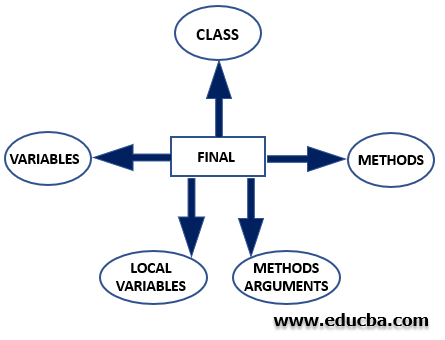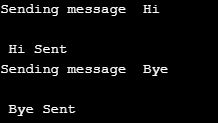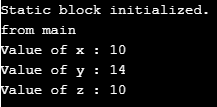ホームページ >Java >&#&チュートリアル >Java の非アクセス修飾子
Java の非アクセス修飾子
- 王林オリジナル
- 2024-08-30 15:59:18761ブラウズ
非アクセス修飾子は、クラスの動作、メソッド、変数などについて JVM に通知するために Java 7 で導入されたキーワードです。これは、変数を 2 回初期化できないことを示すために使用される最後のキーワードなど、追加機能の導入に役立ちます。合計 7 つの非アクセス修飾子が導入されています。
- 静的
- 決勝
- 要約
- 同期
- 一時的
- strictfp
- ネイティブ
Java の非アクセス修飾子の種類
Java の非アクセス修飾子の種類は次のとおりです:
広告 このカテゴリーの人気コース JAVA マスタリー - スペシャライゼーション | 78 コース シリーズ | 15 回の模擬テスト1.最終的な非アクセス修飾子
この修飾子は以下で適用できます:
- クラス
- メソッド
- インスタンス変数
- ローカル変数
- メソッドの引数

- Final Class: Final キーワードは、他のクラスによるクラスの継承を制限する場合にクラスで使用されます。たとえば、最終クラス Honda がある場合、このクラスを拡張しようとするとコンパイル時エラーが発生する可能性があります。
コード:
final class Honda{
public void myFun1(){
System.out.println("Honda Class");
}
}
class Bike extends Honda{
public void myFun1(){
System.out.println("Bike Class");
}
}
出力:

- Final メソッド: Final キーワードは、このメソッドがどのサブクラスでもオーバーライドされることを意図していないことを Java ランタイム環境に示すために使用されます。
コード:
class Honda{
public final void myFun1(){
System.out.println("Honda Class");
}
}
class Bike extends Honda{
public void myFun1(){
System.out.println("Bike Class");
}
}
出力:

- Final Variable: Final キーワードは、変数の値への変更を制限するために変数とともに使用され、JVM が変数を定数として扱うように指示します。これは、最終変数は 1 回だけ初期化できることを意味します。
2.抽象非アクセス修飾子

- 抽象クラス: クラスは、このクラスがインスタンス化できないことを示すために抽象として宣言されます。つまり、このクラスに対してオブジェクトは作成できませんが、継承は可能です。それでも、このクラスには、そのサブクラスのコンストラクター内で呼び出されるコンストラクターがあります。これには、最終メソッドだけでなく抽象メソッドも含めることができ、抽象メソッドはサブクラスでオーバーライドされます。
コード:
public abstract class MyActivity{
public MyActivity(){
}
public final String myFun1(){
}
}
- 抽象メソッド: 抽象メソッドは定義のないメソッドです。これにはメソッドのシグネチャのみが含まれており、これらをサブクラスでオーバーライドする必要があることを示すことを目的としています。
例: public abstract void fun1();
コード:
abstract class Electronics
{
abstract void display();
abstract void display(String msg);
}
class Computers extends Electronics
{
@Override
void display() {
System.out.println("Abstract method is called");
}
@Override
void display(String txt) {
System.out.println(txt);
}
}
public class AbstractDemo {
public static void main(String[] args) {
Computers obj=new Computers();
obj.display();
obj.display("Method with arguments");
}
}
出力:

3.同期された非アクセス修飾子

このキーワードは、複数のスレッドによる 1 つのメソッドへの同時アクセスを防止するのに役立ちます。これにより、プログラムのフローが同期され、マルチスレッド機能を使用して望ましい結果が得られます。
コード:
class Person1
{
public synchronized void sendFun(String txt)
{
System.out.println("Sending message\t" + txt );
try
{
Thread.sleep(1000);
}
catch (Exception e)
{
System.out.println("Thread interrupted.");
}
System.out.println("\n" + txt + "Sent");
}
}
class DemoThread extends Thread
{
private String txt;
Person1 person;
DemoThread(String m, Person1 obj)
{
txt = m;
person = obj;
}
public void run()
{
synchronized(person)
{
person.sendFun(txt);
}
}
}
public class HelloWorld
{
public static void main(String args[])
{
Person1 snd = new Person1();
DemoThread S1 =
new DemoThread( " Hi " , snd );
DemoThread S2 =
new DemoThread( " Bye " , snd );
S1.start();
S2.start();
// wait for threads to end
try
{
S1.join();
S2.join();
}
catch(Exception e)
{
System.out.println("Interrupted");
}
}
}
出力:

4.静的非アクセス修飾子

この変数はメモリ管理に使用され、クラスのロード中に最初に参照されます。これらのメンバーはクラス レベルで扱われます。したがって、オブジェクトを使用して呼び出すことはできません。代わりに、クラスの名前がそれらを参照するために使用されます。
- Static Variable: If a variable is declared as static, then only a single copy of the variable is created and shared among all the objects. Thus any change made to the variable by one object will be reflected in other others. Therefore, the variables that hold value on the class level is declared as static.
- Static Class: Static keyword can only be used with nested classes.
- Static Methods: Since Static Methods are referenced by class name thus can only access static member variables and other static methods. Also, these methods cannot be referred to using this or super pointer. The main method is the most common example of a static method that always get loaded while its class is being loaded.
- Static Block: This is said to be a block being used to perform certain operations while class is being loaded. Since it is static thus can use only static members of the class.
Code:
public class Demo
{
// static variable
static int x = 10;
static int y;
//static class
public static class DemoInnerClass{
static int z=10;
}
// static block
static {
System.out.println("Static block initialized.");
y = x + 4;
}
//static method
public static void main(String[] args)
{
System.out.println("from main");
System.out.println("Value of x : "+x);
System.out.println("Value of y : "+y);
System.out.println("Value of z : "+DemoInnerClass.z);
}
}
Output:

5. Native Non Access Modifier

The native keyword is used only with the methods to indicate that the particular method is written in platform -dependent. These are used to improve the system’s performance, and the existing legacy code can be easily reused.
Note: Static, as well as abstract methods, cannot be declared as native.Example: Consider a function myfun1 in class NativeDemo that is written in C++. To use this code, we will create a link library mylib1 and load it using the class’s static block.
public class DateTimeUtils {
public native String getSystemTime();
static {
System.loadLibrary("nativedatetimeutils");
}
}
6. Strictfp Non-Access Modifier

- Strictfp Class / Method: This keyword is used to ensure that results from an operation on floating-point numbers brings out the same results on every platform. This keyword can not be used with abstract methods, variables or constructors as these need not contain operations.
Code:
public class HelloWorld
{
public strictfp double calSum()
{
double n1 = 10e+07;
double n2 = 9e+08;
return (n1+n2);
}
public static strictfp void main(String[] args)
{
HelloWorld t = new HelloWorld ();
System.out.println("Result is -" + t.calSum());
}
}
Output:

7. Transient Non-Access Modifier
While transferring the data from one end to another over a network, it must be serialised for successful receiving of data, which means convert to byte stream before sending and converting it back at receiving end. To tell JVM about the members who need not undergo serialization instead of being lost during transfer, a transient modifier comes into the picture.
Syntax:
private transient member1;
Code:
import java.io.*;
class Demo implements Serializable
{
int x = 10;
transient int y = 30;
transient static int z = 40;
transient final int d = 50;
public static void main(String[] args) throws Exception
{
Demo input = new Demo();
FileOutputStream tos = new FileOutputStream("abc.txt");
ObjectOutputStream tin = new ObjectOutputStream(tos);
tin.writeObject(input);
FileInputStream fis = new FileInputStream("abc.txt"); ObjectInputStream ois = new ObjectInputStream(fis);
Demo output = (Demo)ois.readObject();
System.out.println("x = " + output.x);
System.out.println("y = " + output.y);
System.out.println("z = " + output.z);
System.out.println("d = " + output.d);
}
}
Output:

Conclusion
Non-access modifiers are the type of modifiers that tell JVM about the behavior of classes, methods, or variables defined and prepared accordingly. It also helps in synchronizing the flow as well as displaying similar results from operations being performed irrespective of the platform used for execution.
Recommended Article
This is a guide to Non Access Modifiers in Java. Here we discuss the Types of Non Access Modifiersand their methods and code implementation in Java. You can also go through our other suggested articles to learn more –
- Layout in Java
- Java Compilers
- Merge Sort In Java
- Java BufferedReader
以上がJava の非アクセス修飾子の詳細内容です。詳細については、PHP 中国語 Web サイトの他の関連記事を参照してください。

